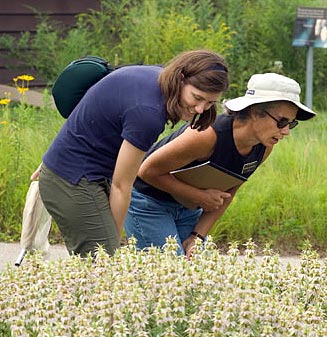Native pollinators: Key to sustainable fruit production?
As a group of students ogles wild flowers on a sunny day at the UW Arboretum, the blooming dotted mint, iron weed and black-eyed susans are certainly glorious. But these adult students are not concentrating on the flowers. Instead, they are focusing on the insects busily pollinating those blooms. Wasps. Flies. Beetles. And a dozen species of native bees, including several species of bumblebee.

Jennifer Hopwood (left), pollinator specialist from the Xerces Society and Susan Carpenter, Arboretum native plant gardener, examine pollinators on dotted mint Aug. 3, 2010, during a workshop on native pollinators at the UW–Madison Arboretum, sponsored by the UW–Madison Center for Integrated Agricultural Systems.
Photo: Molly Fifield-Murray, UW–Madison Arboretum
The class, including graduate students, conservation officials, Arboretum employees and two people from the fruit industry, is interested in promoting native pollinators as a replacement for the ever-scarcer colonies of honeybees.
The workshop is sponsored by the Eco-Fruit Project, a statewide program coordinated by UW–Madison’s Center for Integrated Agricultural Systems that is helping fruit growers reduce pesticide use, lighten their impact on the land, and improve profitability and marketability.
Today’s instructor is Jennifer Hopwood of the Xerces Society, which advocates conservation of insects and other invertebrates. The Xerces Society and the Cooperative Extension Conservation Professional Training Program have partnered with the university to help deliver these courses.
Hopwood points out many advantages for native pollinators, which, unlike honeybees, come with the territory and need not be rented.
Some native bees, Hopwood says, are dramatically more industrious than honeybees.
Native pollinators interested workshop attendee Richard Schneider of Calamus Creek Farms in Columbus, Wis., a small apple producer with a diversified farm. “There’s such a variety of pollinators, and people have not been paying attention to them. There’s a lot of education needed.”
The origins of Eco-Fruit date to 2000, when apple growers in southeast Wisconsin came to Michelle Miller of the integrated agriculture center. The growers were worried about impending bans on their two main insecticides. At the same time, consumers were becoming more concerned about pesticides in food.
Miller collaborated with the Wisconsin Apple Growers Association and UW-Extension fruit specialists to design a program of participatory research that started from these grower concerns.
Regina Hirsch, an outreach specialist at the center, says the growers organized into regional networks. They also adopted integrated pest management, a strategy that bases pesticide decisions on weather, insect populations and economics, rather than spraying on a preordained schedule.
Within three years, the toxic burden of their sprays was cut in half, says Hirsch.
As more growers around the state became interested, the Eco-Apple Project expanded into other parts of the state.
After other Wisconsin fruit growers joined Eco-Apple, the name was changed to the Eco-Fruit Project, but the goals remained the same: to use participatory research to learn to grow fruit more efficiently, profitably and sustainably.
Eco-Fruit now has at least 70 participants in five networks in Wisconsin.
Most commercial fruits must be pollinated by animals — typically bees — and as honeybees continue to suffer what’s known as colony collapse disorder, the Eco-Fruit Project is working to improve conditions for honeybees and native pollinators alike.
The Arboretum workshop is one of six being held around the state, where growers, conservationists and scientists are assembling to discuss native pollinators.
Natives have significant advantages, says Hirsch. “Wisconsin apples bloom in April, when it’s cold and rainy. Honeybees don’t like to work under those conditions, but bumblebees will still be pollinating, and in that short period of blossoming, you want something hardy out in your orchard.”
A big part of the job is creating or conserving habitat where native bees can nest and eat, says Hirsch. “Natives can shoulder more of the burden if we develop natural habitat with a variety of flowering plants that bloom throughout the season. It might take a while to reach 100 percent, but they can definitely play a role.”
For a schedule of upcoming workshops, visit http://conservation-training.wisc.edu/course_listing/list_sections?course_id=7.
Subscribe to Wisconsin Ideas
Want more stories of the Wisconsin Idea in action? Sign-up for our monthly e-newsletter highlighting how Badgers are taking their education and research beyond the boundaries of the classroom to improve lives.



